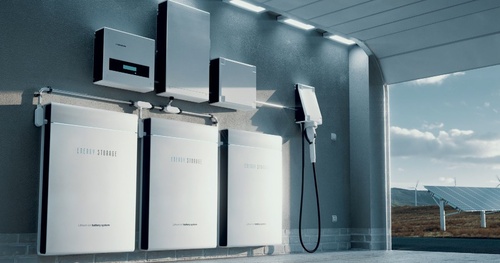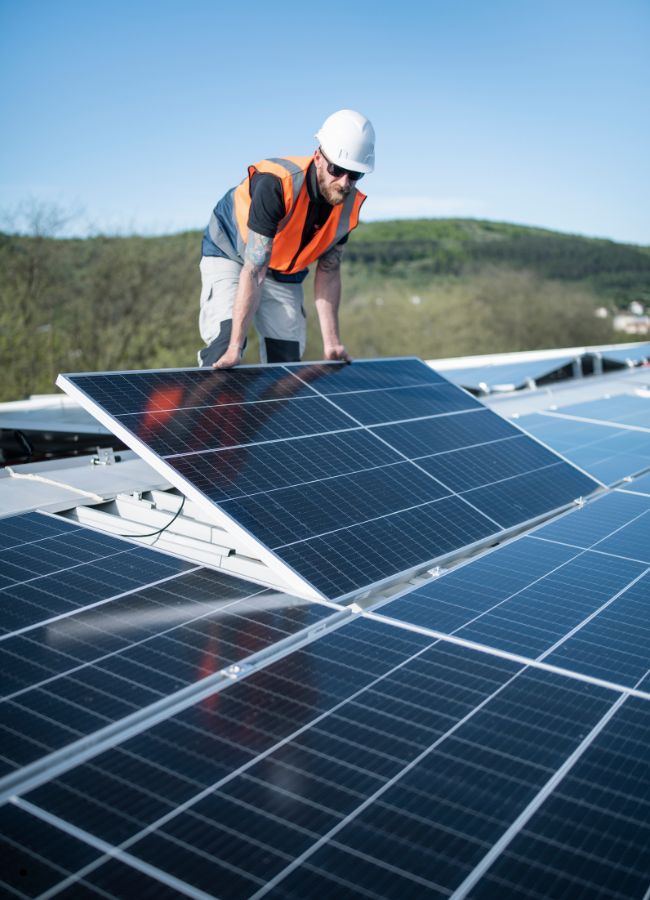As the world shifts toward renewable energy, solar battery storage is emerging as a critical component for sustainable power solutions. Solar battery storage systems enable homeowners and businesses to store excess solar energy during sunny hours, improving energy efficiency, and resilience against power outages, reducing grid reliance, and potentially leading to cost savings. This blog explores the fundamentals, benefits, types, and greener energy consumption transformation.
Explore the process of installing solar battery storage and what to expect at each stage. Plus, learn whether installing a solar-plus-storage system upfront or adding a battery later makes more
sense.
The Benefit Of Solar Battery Storage in Australia
A solar battery storage system provides an off-grid power solution, ensuring uninterrupted electricity access during power outages or blackouts. solar battery storage systems provide numerous
benefits:
The adoption of solar battery storage in Australia is rapidly gaining momentum, offering substantial benefits for both homeowners and the national energy grid. For consumers, batteries significantly increase solar self-consumption, allowing them to store excess daytime energy for use during expensive evening peak times, thereby slashing electricity bills and reducing reliance on grid power.
This enhanced energy independence also provides essential backup power during blackouts, improving household security and resilience. On a broader scale, the collective use of battery storage, particularly through Virtual Power Plants (VPPs), helps to stabilise the electricity grid and better integrate Australia’s abundant renewable energy, ultimately contributing to lower carbon emissions and a cleaner energy future.

Lower Electricity Bills
Storing and utilizing your energy can significantly reduce your energy bills, potentially eliminating your electricity bill depending on your battery capacity and usage.
Self-Reliance On Energy
The storage of solar energy for future use enhances the self-sufficiency of both interconnected and off-grid systems. Solar charge controllers are utilized in off-grid systems to maintain batteries at their optimal charge without overcharging them, thereby preventing gassing and battery damage.
Optimisation Of Time
home battery storage can optimize energy consumption throughout the day, reducing electricity rates and reducing costs associated with peak demand periods for major appliances.
Shifting Loads
Battery storage systems enable load shifting, allowing for the adjustment of energy usage without affecting overall consumption.
Backup Power
Energy security and resiliency are crucial during blackouts or cloudy days with insufficient sunlight.
Grid Stability
Solar batteries enhance grid stability by regulating system frequency, allowing them to adjust frequency deviations from the standard 50 Hz through continuous grid monitoring.
Sustainability
Solar energy storage systems offer a renewable energy alternative and are eco-friendly, as they don’t rely on fossil fuels like generators.
Solar Energy Storage Installation Process
The solar battery storage installation process involves site assessment, system design, procurement, installation, wiring, connection, testing, commissioning, and maintenance for optimal performance and longevity.
Site Assessment
A site assessment evaluates property physical characteristics like roof orientation and space for solar system installation and battery placement. It also assesses energy usage patterns, identifies improvements, and estimates battery storage system size and capacity.
Permitting
Permitting requirements for solar installation vary by location and regulations. It involves submitting applications, providing project details, and ensuring compliance with local building codes and
safety standards. Consulting with a professional installer or local authorities ensures smooth approvals.
Improvements In Electrical Systems
Electrical upgrades may be necessary to ensure safety and efficiency during the installation of a solar battery storage unit. These may include panel modifications, dedicated circuit installation,
or wiring reinforcement. A professional assessment identifies necessary upgrades and compliance with local codes.
Racking And Mounting
Solar batteries are typically stored in a designated area within a home, such as a utility room, basement, garage, or outdoor enclosure. The placement depends on space, environmental conditions, and safety. Mounting and racking secure the batteries and equipment for stability, ventilation, and easy maintenance and monitoring.
Inverter Connection
The installation process involves connecting the solar battery storage system to the inverter, which converts stored energy into AC for home use. Professional installers ensure proper wiring and safe configuration for the solar panels, battery storage system, and electrical panel.
Factors to Consider While Installing Solar Battery Storage
Several factors are essential to ensure optimal performance, cost-efficiency, and long-term benefits when installing a solar battery storage system. Here are key factors to consider:
Energy Consumption
To select the right battery size and capacity, consider your daily energy usage, peak usage times, total consumption, and anticipated changes like electric vehicles or appliances.
Battery Capacity
Battery capacity, measured in kWh, indicates the total energy a battery can store, while power rating, in kW, indicates its ability to deliver power simultaneously. High-capacity batteries last longer, while high-power ones support heavy appliances.
Battery Type
Lithium-ion and lead-acid batteries are common, with lithium offering longer lifespans, higher efficiency, and better depth of discharge, influencing cost, efficiency, and durability.
Solar Battery Chargers
Solar battery chargers are crucial for emergency preparedness, providing a reliable power source for critical devices like flashlights, radios, and communication during power outages.
Financial And Cost
Solar batteries are a costly investment, but many regions offer incentives, tax credits, and rebates for installation. Evaluate local incentives and potential energy bill savings for cost-effectiveness.
The solar battery cost in Australia ranges from $800 per kWh to $2000 kWh depending mainly on how much energy you want to store.
Backup Power
Choose a battery with a seamless switchover feature for power outages, verify backup capabilities, and choose a battery with a seamless switchover for grid outages.
Warranty
Choose batteries with 10-year warranties that cover performance and capacity retention, ensuring reliable service without unexpected costs.
Installation Space And Climate Changes
The location of the battery should be carefully considered, as extreme temperatures can impact its performance, and many batteries are designed for indoor or temperature-controlled environments.
Conclusion
In conclusion, Solar battery storage is a significant advancement in clean energy, offering environmental and economic benefits. It allows homeowners and businesses to store excess solar power, maximizing renewable energy usage, reducing electricity costs, and enhancing grid resilience.
As technology advances, solar battery storage becomes more accessible, promoting a sustainable, resilient, and renewable-powered world. You can find the Best EV Charger installation guide from GOAL Solar.



